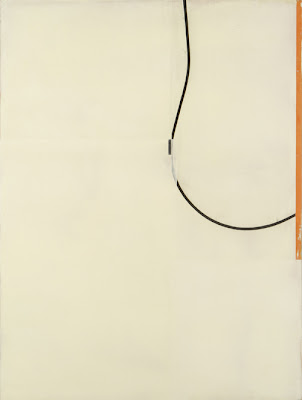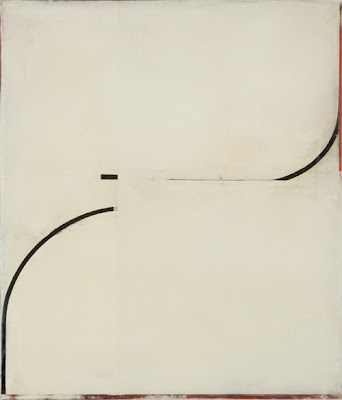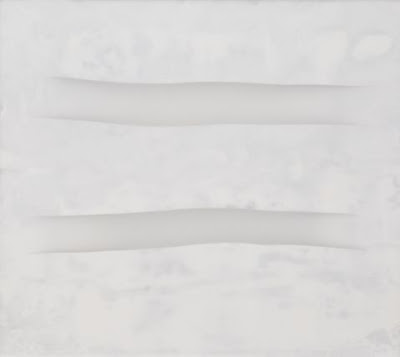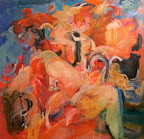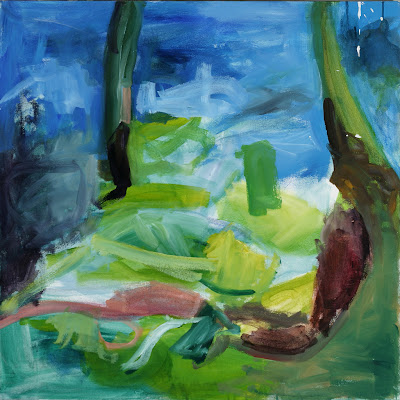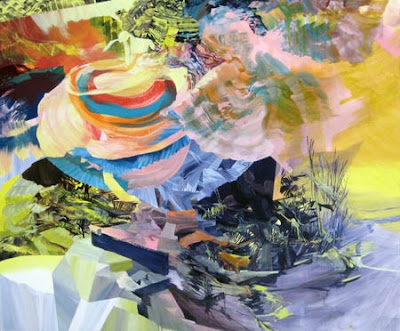Jill Christian
Advisor: Laurel Sparks
Critical Theory I Paper
In the quiet, private space of my studio, I look at a painting I am working on—gestural, suggestive of the figure, abstract expressionistic in style (perhaps not entirely original, I think)—and I recall a statement from the June Critical Theory seminar. That painting today is barely visible on the horizon; art today is in the media, the Internet. It is now part of the entertainment industry and we are cynical about it (Steck). And, thinking about this, I feel a certain anxiety similar to that described by Leo Steinberg in his essay, “Contemporary Art and the Plight of Its Public,” “…a sense of loss, of sudden exile, of something willfully denied—sometimes a feeling that one’s accumulated culture or experience is hopelessly devalued, leaving one exposed to spiritual destitution” (7). Nevertheless, I feel, like Steinberg, that this is somehow “all right”.
Over the past month, in response to the Critical Theory seminar and readings, I have been thinking about how I participate in a “collaboration with culture” and how I have been indoctrinated by the culture I live and work in—specifically the culture of art school, art institutions, and art history. I have also been revisiting and exploring in new ways the history of Abstract Expressionism, one of my primary influences as a painter.
I came to Abstract Expressionism in a linear progression. As a child, I began like every other child drawing and painting the things I saw around me: my family, my house, the trees, the sky. As a teenager I turned to portraiture, obsessively copying images of faces I saw in fashion magazines. Once in formal art classes as a college student, I first drew and painted still lifes, landscapes, and figures—as realistically as I could. Then, as I was exposed to more formal art history, I tried on various styles and approaches: Expressionism, Fauvism, Cubism, and Surrealism. My education and experiments roughly followed the narrative of art history described by Mary Anne Staniszewksi in
Believing Is Seeing: Creating the Culture of Art: “The story of Modern Art, until the beginning of the twentieth century, is one of gradual development, from realistic, illusionistic representations to more abstract, ‘ideal’ images “(183). In my travels along this path of stylistic “development”, I arrived finally at Abstract Expressionism.
I was particularly drawn to Action Painting. There was something about the vitality I felt when painting in this manner—using broad gestures, physically moving around the canvas, and intuitively grabbing colors off the palette. Working in this way gave me permission to physically and authoritatively “attack” my subject matter (which was particularly liberating to me as quiet person, generally more comfortable listening than expressing). I fell hard for what Ann Eden Gibson calls “the myth of Abstract Expressionism’s creative vigor, originality, and force” (xxiii). I was enthralled with the personas I encountered in reading about the movement and the historical time period—a time of intense intellectual activity and rugged individualism, with artists creating new, vibrant, monumental, energy-filled works of art. Though, perhaps not so new after all. Staniszewski argues that Abstract Expressionism, a product of the rise of the liberal democratic state, post-war consumerism, and capitalist society, was “the beginning of a recycling of previous styles (p. 260)”, which foreshadowed that aspect of post-modernism.
I was unaware that I was ingesting and adopting the stylistic approaches and attitudes of Abstract Expressionism without understanding the context in which the movement existed. I was oblivious to the notion that the “essential eight” painters (Gottlieb, de Kooning, Motherwell, Newman, Pollock, Reinhardt, Rothko, and Still) whom I read about and looked at had been elevated by cultural institutions to the exclusion of other painters—notably painters who were not heterosexual white males. Nor had I examined how this movement and the artists working in it were profoundly shaped by the historical time in which it occurred, and what was at stake for both the artists who were privileged by recognition and the institutions that collaborated in accepting some and excluding others – indeed, Gibson argues that even the art “culture” of today has a vested interest in maintaining the narratives that surrounded Abstract Expressionism, a view shared by Carol Duncan in "The MoMA’s Hot Mamas".
Abstract Expressionism, among other things, came to represent the triumph of not only American painting, but also American “culture”:
"Abstraction had come to stand for a certain kind of frontier heroism
that supported the American ideals of universalism, individualism,
and freedom. Generally speaking, artists whose style, subject matter,
or personal identity blocked an authoritative espousal of these values
were shoved to the background…the artist who emerged as the
quintessential Abstract Expressionist hero was Jackson Pollock"
(Gibson 2).
Not only did the narrative include a “cult of originality” and elevation of authenticity, (Staniszewski 101) but a dichotomy of values was put into play that roughly included these relationships:
Male........................Female
Non-material realm..........Biological
Air, light, mind............Earth
Mechanical order, control...Unruly nature, uncontrol
Bold, linear................Pretty, decorative
Pure........................Political, racial, narrative
Modern......................Primitive
Conscious...................Unconscious
Original....................Derivative
Pollock.....................Krasner
(developed referring to Duncan, Gibson, and Staniszewksi)In this system, anything that fell on the “feminine” side (regardless of the artist’s actual gender) was devalued. Perhaps more interesting was how white male artists co-opted aspects of the right side column as strategies (use of the primitive, the unconscious, the natural), which if employed by women artists would devalue their work in the “system”. As Gibson said, “Women artists simply could not win” (165).
One important aspect of the Abstract Expressionism canon was the valuing of purity of meaning and the avoidance of the overtly political or narrative, which was expressed as an emphasis on technique and style. In her exploration of non-canonical Abstract Expressionist painters, Gibson points out, “to argue that formal innovation constitutes the crucial limit of Abstract Expressionism is to imply that meaning resides principally in the work itself, rather than in, say, the interaction between the work and the viewer or in the work’s relation to society” (xxviii).
This brings up the question of meaning in Abstract Expressionism and how the current methods of painting in this style interact with today’s viewer and today’s society. In thinking about my adoption of this style, I have been considering the relationship (if any) between my “recycling”, “imitating”, and “pastiche” (as defined by Fredric Jameson). One of the issues I have with Jameson’s critique is that he sets up parody and pastiche as two ends of a spectrum and devalues pastiche as being empty of meaning.
I am interested in exploring how different strategies within Abstract Expressionism were used by artists working outside the “canon” and looking at how recycling and borrowing works in my painting and in how other abstract painters are working in the context of both history and contemporary culture and imagery. I reluctantly admit that I am strongly attached to the “the traditions and mythologies related to an artist’s mastery of the strokes of paint on the canvas” and “the artist’s mastery of the absolute and individual domain of creation (Staniszewski 225). However, Staniszewski also points out in her discussion of Picasso, Braque, and Duchamp, that it is through the acknowledgment of the limitations of their practice that artists have “gained more knowledge and power about themselves, their work, and their world in their examination of the way meaning and value are created in Western culture” (225).
The anxiety lies in not knowing what will take the place of the values and habits held dear. “And this, I think, is our plight most of the time. Contemporary art is constantly inviting us to applaud the destruction of values which we still cherish, while the positive cause, for the sake of which the sacrifices are made, is rarely made clear” (Steinberg p. 10).
I choose to take the positive position of Staniszewksi, that “If we accept the fact that everything is shaped by culture, we then acknowledge that we can create our reality. We therefore contribute to it and can change it. This is an empowering way of living and of seeing ourselves in the world” (298).
Works CitedDuncan, Carol. “The MoMA’s Hot Mamas.”
The Expanding Discourse: Feminism and Art History. Ed. Norma Broude and Mary D. Garrard. New York: HarperCollins, 1992, 347-357. Print.
Gibson, Ann Eden.
Abstract Expressionism: Other Politics. New Haven: Yale University Press, 1997. Print.
Jameson, Fredric. “Postmodernism and Consumer Society.”
The Anti-Aesthetic: Essays on Postmodern Culture. Ed. Hal Foster. New York: The New Press, 1998, 127-144. Print.
Staniszewksi, Mary Anne.
Believing Is Seeing: Creating the Culture of Art. New York: Penguin Books, 1995. Print.
Steck, Stuart. “Critical Theory I.” The Art Institute of Boston, Boston. June 2009. Lecture.
Steinberg, Leo. “Contemporary Art and the Plight of Its Public (1962).”
Other Criteria: Confrontations with Twentieth-Century Art. New York: Oxford University Press, 1972, 3-16. Print.
